Menu
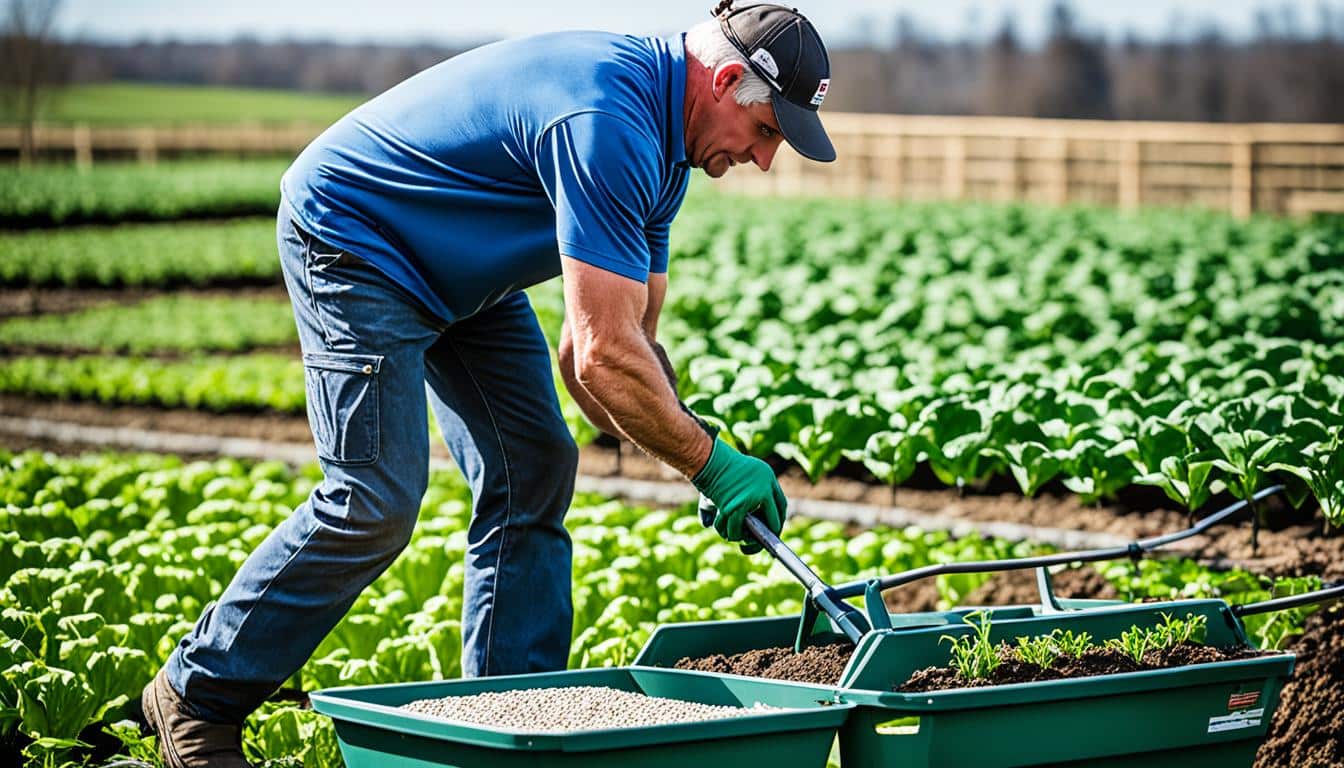
Backaches, along with shoulder and arm pains, are very common among farm workers. These symptoms often result from work-related musculoskeletal disorders. This is a major cause of disability in the working population. So, it’s crucial to assess farm tasks ergonomically.
In California, the annual cost of workers’ compensation for back injuries exceeds $22 million for 3,000 cases. Clearly, farm health issues have serious financial costs. Ergonomic solutions aim to protect worker health and enhance profits for growers. Small changes can reduce physical stress and economic burdens.
Ergonomic assessments look closely at work environments to improve posture and reduce strain. They aim to lessen the risk of injury from poor ergonomics. This leads to a safer, more efficient work setting.
Farm ergonomics helps adjust work to fit farm workers’ needs. This boosts their health and how well they work. Most farm tasks have ergonomics issues, including using machines and handling animals. It’s key to do ergonomic assessments for farm tasks to find and fix these problems. Taking this approach can really make farm work better.
Working on farms can cause big health problems like sprains and back injuries. These were the most common reasons for injury claims in NSW in 1988/89. In Queensland, sprains and strains led to over 1000 claims in one year, costing over $3,500,000. These facts show why it’s crucial to include ergonomic measures in farm work. This can lower injury rates.
Heavy lifting and other manual jobs in farming can cause hernias and back pain. This is a big issue, with half of agricultural workers getting back pain at some point. Using ergonomic tools for farmers is vital. Each year, over 160 million farm workers get sick because of their jobs. The ILO says more than 2.3 million die yearly due to work illnesses and accidents.
Agricultural ergonomics focuses on what the human body can handle. Ergonomic tools for farmers aim to stop harm from doing hard or repetitive tasks. The farm ergonomics goal is to make farming safer and more efficient. This could lead to a workforce that works better and stays healthier.
The data shows we need farm ergonomics for farm workers to be healthier and more efficient. Doing ergonomic assessments for farm tasks can find risks and cut down on injuries. By using farm ergonomics, farming could see big improvements. It offers a way to make farming safer and more productive.
Farming requires a lot of physical work, making farm ergonomics very important. One big issue is musculoskeletal disorders (WMSDs). These problems really affect health and safety on farms.
WMSDs are a big worry in farm work. They come from doing the same motion a lot and from working too hard. Many farm workers complain of back, shoulder, arm, and hand pains. This is because working in the fields often means bending in strange ways, lifting heavy things, and doing the same movements over and over. These activities make it more likely to get hurt. In fact, a lot of injuries causing people to miss work are because of sprains and strains. Back injuries are also very common. Just in California, treating back injuries of more than 3,000 farm workers costs over $22 million each year.
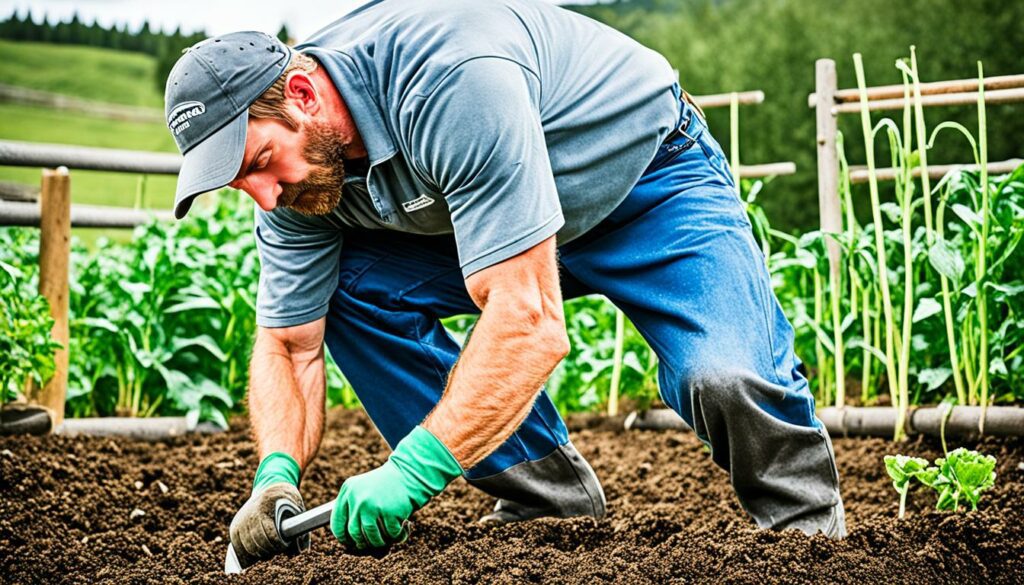
Bad posture makes farm work problems worse. This is because workers might have to bend, twist, or reach to do their jobs. Using machinery, tools, or working with animals means they might work in hard positions. Vibration from machines can also hurt them. Making tools better and changing how work happens can lower the chance of these injuries. By teaching workers to move and work better, and by avoiding doing the same thing over and over, we can stop many of these injuries.
| Issue | Impact | Cost Implications |
|---|---|---|
| Back Injuries | 33% of missed workdays | $22 million annually in California |
| Sprains and Strains | 25% of missed workdays | High compensation costs |
| Repetitive Movements | Musculoskeletal disorders | Reduced productivity |
| Vibration from Equipment | Increased injury risk | Medical expenses |
Farm ergonomics works on making farm tasks easier and safer for workers. By fixing problems early and choosing smart solutions, farm owners can avoid a lot of health issues. Farming can be a much safer place to work.
Integrating ergonomic assessments for farm tasks brings many pluses. The top advantage is spotting and cutting down physical strain early. This is crucial for keeping farm worker safety high.
Agricultural workplace assessments highlight a problem. Many injuries that make workers stay off work are due to sprains, strains, and back pain. These come from doing the same movements over, holding awkward poses, and lifting heavy things.
By doing ergonomic assessments for farm tasks, we catch these dangers early. We then change how tasks are done. This might mean making tools better or tasks easier. Doing this lowers the chance of work-related musculoskeletal disorders (WMSDs). This strategy lifts farm worker safety and cuts costs on injury pay. For example, in California, just for back injuries, over $22 million is spent in compensation every year. This shows the big money savings of preventing physical strain in agriculture.
Ergonomic improvements also boost farm efficiency. When jobs are set to match what workers can do, they do better. They work easier and happier, which means the job is higher quality and they tire less.
Making the workspace better with ergonomic designs helps workers stay comfortable for longer. This lifts their mood and productivity. So, ergonomic changes are good for health and the farm’s success.
In ergonomic assessments for farm tasks, a lot of attention goes to the movements and actions needed for the job. It’s also about picking and using the right tools. This helps make tasks easier and less tiring for farm workers.
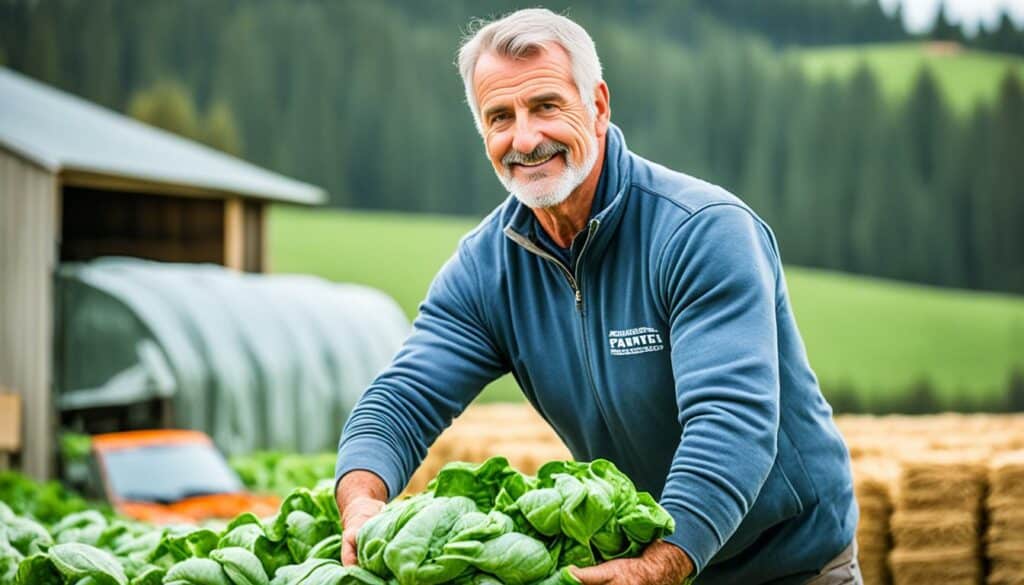
Focusing on how tasks are done on the farm is key. It’s important for these actions to flow smoothly and avoid sudden movements. By looking at this, we figure out how to do tasks in ways that stop the need for bending, twisting, or reaching too much. This cuts down on tired muscles and the risk of getting hurt.
This detailed look at how tasks are performed helps make farm work more efficient. It tackles the common problems that farmers face with their work tools.
Giving farm workers the right tools is critical in keeping them safe. Tools that are designed to be easy on the body, like those with special handles or carts, are game-changers. They protect the workers and make the job smoother and faster.
These specially designed tools ease the workload and prevent injuries. This approach to tools also keeps farm workers healthy and happy, reducing risks like muscle issues.
Take a look at some key data in ergonomics:
| Ergonomic Aspect | Data Point |
|---|---|
| Common Symptoms | Backaches, pain in shoulders, arms, hands |
| Injury Statistics | 1/3 injuries are sprains and strains, 1/4 are back injuries |
| California Workers’ Compensation | $22 million for 3,000+ back injuries annually |
| Cause of WMSDs | Chronic physical stresses: bending, lifting, vibrating equipment |
Ultimately, crafting farm tasks with good ergonomics at heart is crucial. It ensures that agriculture is a safe, efficient, and lasting field to work in.
Finding hazards in farm work is key to keep farm workers healthy. Musculoskeletal issues are a big problem for them. So, I watch them work and talk to them.
These steps help spot and fix problems to make their jobs safer and more comfortable.
To check for dangers on the farm, I use lists and walk around. These help me see what might hurt workers, like lifting injuries or pains in their arms and hands.
By paying close attention and keeping notes, I figure out how to make their work areas safer.
Talking to farm workers is a huge help. They tell me the real issues they face every day. This way, we can find and fix problems not seen by just looking.
Their feedback helps in making real solutions, like cleaning up or fixing things. This makes their jobs better and stops injuries.
In California, back injuries are a big deal in farming, costing over $22 million a year. But, by watching and listening to workers, we can make farms safer and save money. This shows how important these steps are for everyone.
Using practical strategies in farming can lessen the physical effort needed and make tasks more efficient. It focuses on keeping farm workers healthy. Making some key changes helps workers avoid getting tired or hurt.
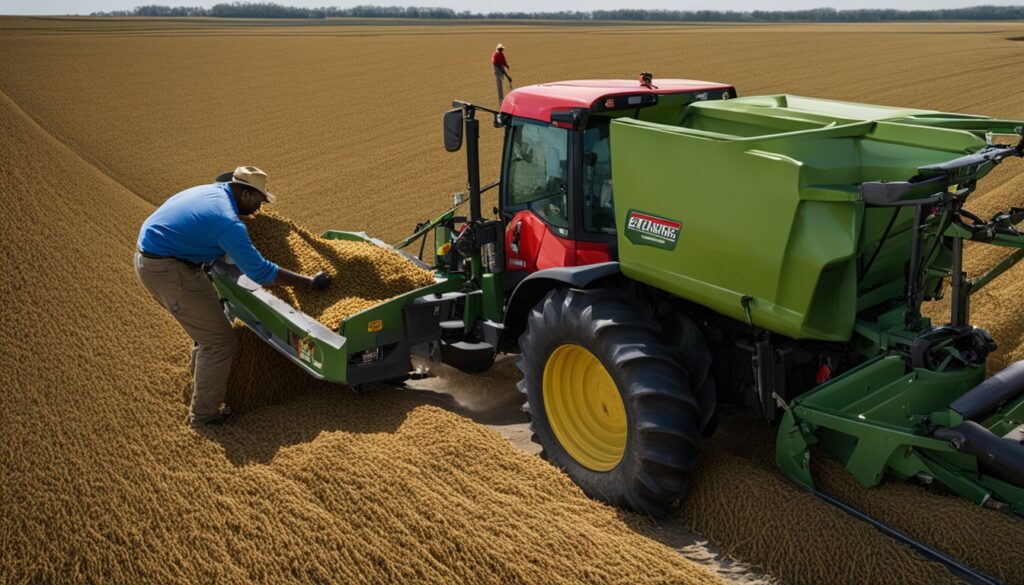
Change the setup in places like packing sheds so that workers don’t have to bend over or twist too much. This can help stop muscle and bone pain, a big issue for farm workers.
Applying better tools and gear is crucial. They should fit well and make work easier. This can stop accidents and cuts down on how tired workers get. It’s also helpful to switch up tasks so workers move in different ways, preventing muscle strain from building up.
Creating work areas that are good for the body is important too. Doing this shows real care for the people working on the farm. Ergonomics is about making sure jobs fit the workers, keeping them safe and happy, and boosting how well they work.
Studying how ergonomic changes help in agriculture shows us the real benefits. These real-life stories prove that making things easier for workers can improve their health and how efficient they are.
At plant nurseries, they’ve made farming tasks less physically taxing. They did this by using plant stands that angle plants towards the worker. This way, they can pot without as much reaching and bending, making their job easier.
Ergonomic checks at these places also showed that keeping tools nearby is vital. This cuts down on a lot of movement, making the job safer and more efficient. It helps prevent injuries like work-related musculoskeletal disorders (WMSDs).
Picking fruit is tough on the body with all the bending and stretching. Yet, ergonomic changes have made big differences here.
Things like using smaller tubs and special carts help spread the load better. They also cut down on the need to bend and stretch too much. This makes picking fruit a less straining job for workers.
Studies have shown the positive results of these changes. They reduced the risk of low-back disorders, a common issue:
| Task | Tool | LBD Risk Reduction |
|---|---|---|
| Carrying | Ergo Bucket Carrier (EBC) | 41% |
| Dumping | Ergo Bucket Carrier (EBC) | 69% |
| Lifting | Easy Lift (EL) | 55% |
These success stories in farm ergonomics show the power of smart changes. They benefit workers a lot, proving that checking and improving work environments regularly can make farming safer and more productive.
Using ergonomic rules can cut the danger of muscle and bone harm for farmers. Such methods focus on good use of tools and how to lift heavy stuff right. This makes work both safer and more efficient.
Farm workers often suffer from back, shoulder, arm, and hand pain. This brings the importance of using tools that are easy on the body. Tools should have grips that don’t tire the user’s hands, with space for a 3/8″ overlap between the forefinger and thumb. They should also be covered in materials that stop slipping, like plastic or rubber. Furthermore, it’s helpful if tools have two handles and are at least 4″ long. These changes can reduce fatigue and improve safety when working.
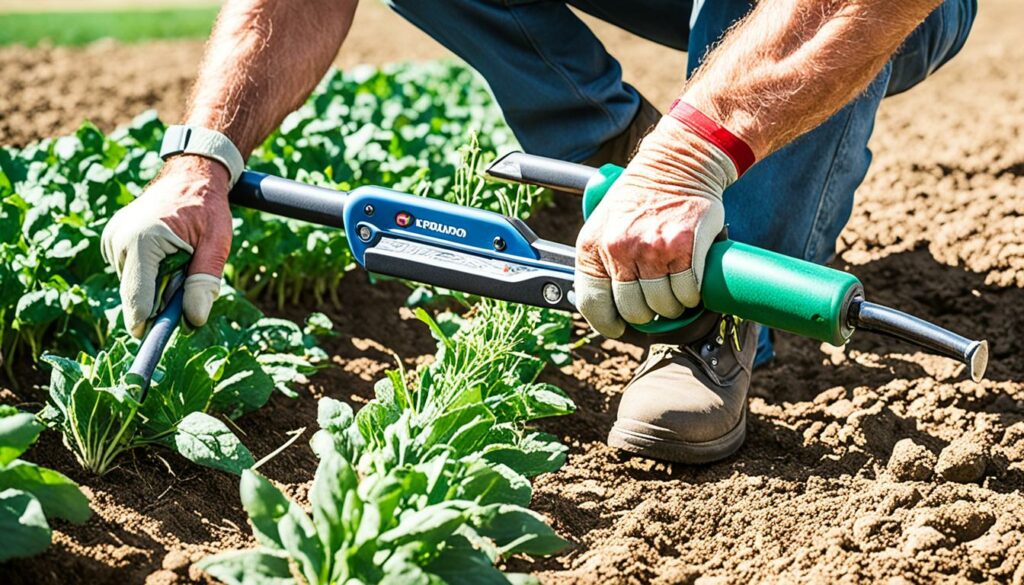
Back injuries are a big issue, causing a lot of missed work. To prevent this, use good lifting methods. Keep the weight between your hands and shoulders. It also helps if things have handles and you use tools like dollies. Following these steps can cut down on muscle and bone injuries.
| Type of Injury | Percentage | Annual Cost in California |
|---|---|---|
| Sprains and Strains | 33% | $7.3 million |
| Back Injuries | 25% | $22 million |
Good tool use and lifting habits are key for farmer safety. They not only make work safer now but also better for the future. They help in keeping a farm running well for longer.
Good training is key to making sure ergonomic solutions work well on farms. It teaches farm workers about ergonomics, safe ways to handle things, and how to use tools right. Workers should know how to avoid getting hurt or tired from the work they do.
Farmers can get hurt a lot, like getting back, shoulder, and arm pains. In California, over 3,000 farm workers’ back injuries cost more than $22 million in workers’ compensation each year. But, teaching them right can lower these costs by making sure they don’t get as many muscle and bone problems. These are the main reasons people in farming can’t work.
Training helps show how to do things more safely, like picking up and carrying stuff. It makes workers understand why and how to change their work to be safer. They learn about the risks and the right ways to do tasks, like lifting and moving things. Using the right tools and knowing how to stand or move the right way can help a lot.
So, teaching workers about ergonomics is crucial. It helps them work better without getting hurt easily. By keeping up with regular training, the farming world can be a safer and more effective place for everyone.
Using a collaborative team approach boosts ergonomic assessments’ success for farm tasks. It’s crucial to involve farm workers in finding problems and creating solutions. As back, shoulder, arm, and hand injuries impact many farm workers, a team effort is key.
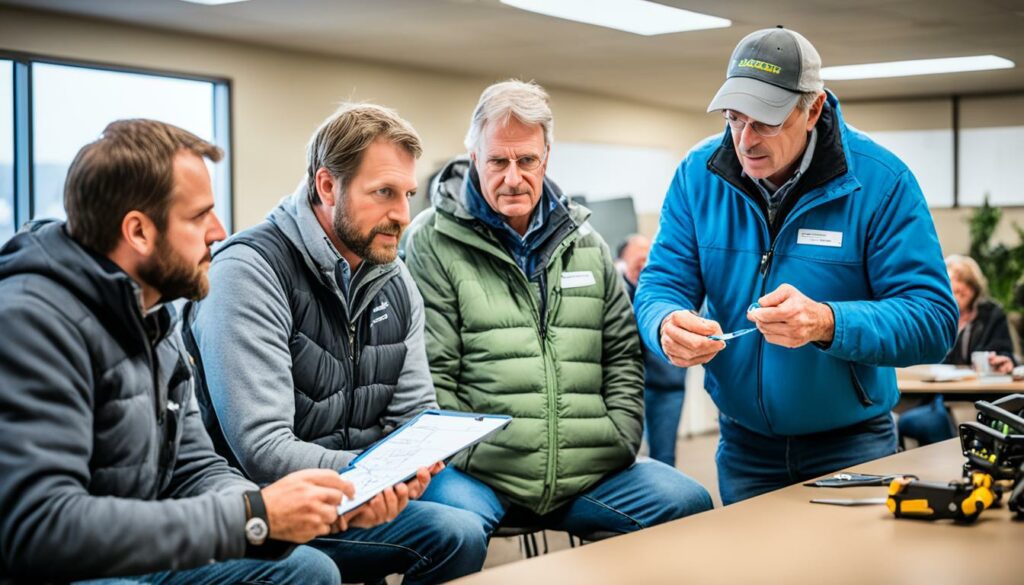
More than 3,000 back injuries happen in California agriculture yearly, costing over $22 million. It shows the importance of ergonomic reviews on tasks like lifting and carrying. Both workers and management need to be involved, building a feeling of teamwork. This teamwork makes it easier to tackle ergonomic issues quickly.
Starting with worker-management teams, this approach uses the knowledge of workers to find solutions. Farm tasks often lead to health issues, so making tasks safer is a must. This way, changes like moving work placements or redesigning tasks have a big impact.
Agriculture often faces high rates of muscle problems, seen in places like Iran and Rajasthan. So, the team effort doesn’t just cut injury rates but also boosts farm productivity and efficiency. This is good for the farm’s economic success.
To sum up, the team approach in farm ergonomics is a strong tool. It helps apply ergonomic strategies well, caring for both the workers’ health and the farm’s economic state.
Small farms need solutions that are budget-friendly yet safe. There are two main types: tweaking tools yourself and adjusting the farm’s layout.
Tweaking tools is a great way to reduce the risk of injuries for small farmers. By changing tools to fit their needs better, farmers cut down on the effort needed. For example, adding soft grips or changing the length of a tool can really help. These changes lower the chance of getting hurt while working.
Changing how your farm is set up can also make a big difference. It’s about cutting down on unnecessary moves and making sure important items are close. For example, keep tools within 17 inches of where they’re needed. Also, use floor mats to make standing more comfortable.
Here’s a table that lists some easy yet effective ergonomic interventions for small farms:
| Ergonomic Solution | Benefit | Implementation Cost |
|---|---|---|
| Cushioned Tool Handles | Reduces hand and grip strain | Low |
| Tool Length Adjustments | Prevents excessive bending and stretching | Low |
| Workspace Reorganisation | Minimises unnecessary movements | Low |
| Floor Mats for Standing Desks | Reduces fatigue for prolonged standing | Low |
| Accessible Tool Positioning | Improves working postures | Low |
These simple tweaks can save both money and health for small farm works. By changing tools and layouts, farmers can work safer and better, all without busting their budget.
Evaluating ergonomic changes is key to keeping farm workers healthy and effective. Looking into the effect of new designs on their health and how well they work is crucial. Research by Herberta et al. found that improving how tasks are done decreased pain in nearly all areas for garment workers.
Gathering info on how workers do their jobs helps a lot. Gangopadhyay et al. saw work improve a lot after changes were made, like less time needed for making parts. This matches with what Das et al. found: a better workstation increased work volume by 22% and quality by 50%.
When checking if ergonomic changes work, it’s vital to look at facts like fewer injuries and better work. But, it’s also key to ask workers how they feel. This gives a full picture of what has been achieved. It’s also important to test efforts in different field conditions to be sure they really help.
Good ergonomic changes don’t only help with aches and pains – they better how well work is done too. In places like India, these issues are very common and can lead to disabilities. So, always looking into and bettering ergonomic plans is very important in the farming world.
Ergonomic solutions adapt work tasks and tools to fit farm workers better. This lowers the risk of health problems. It helps farms run more smoothly, too.
These assessments spot dangers that could cause harm. They make work faster and safer. This means workers feel better and farms do well.
Bad posture can cause body pains and hurt productivity. It also raises the chance of serious health problems among farms workers.
Doing these assessments prevents injuries and boosts how efficiently work gets done. It cuts costs and improves productivity. Plus, it makes the working environment better for everyone.
They look at how workers move and stand. They consider how often they use their hands and for how long. Then, they pick tools and gear that help.
Spotting risks means work can get safer. This reduces injuries that come from how tasks are done. By knowing what’s dangerous, farms can be made safer.
Examples include making tools easier to use, changing work areas to be less straining, and using special tools to make work lighter. These changes cut down on tiredness and the risk of getting hurt.
Yes, some stories show how plants and fruit picking have become easier. This was done by changing how things are done and the tools people use every day.
Use tools that fit your hands and are not slippery. Lift things right. Make sure weights you pick up are safe for you.
Training teaches workers how to work safely and use tools the best way. It’s key to avoiding accidents. Workers who know how to be safe help make farms safer.
It’s when farm workers and their managers work together on making work safer. They share their ideas to come up with good solutions.
For small farms, simple changes can be very helpful. These include adjusting tools, making the layout better, and improving how tasks are done. These steps keep everyone safe and improve work.
Check health and safety records for fewer injuries. See if work is getting done better and easier. Workers’ feedback on how they feel while working also tells a lot.